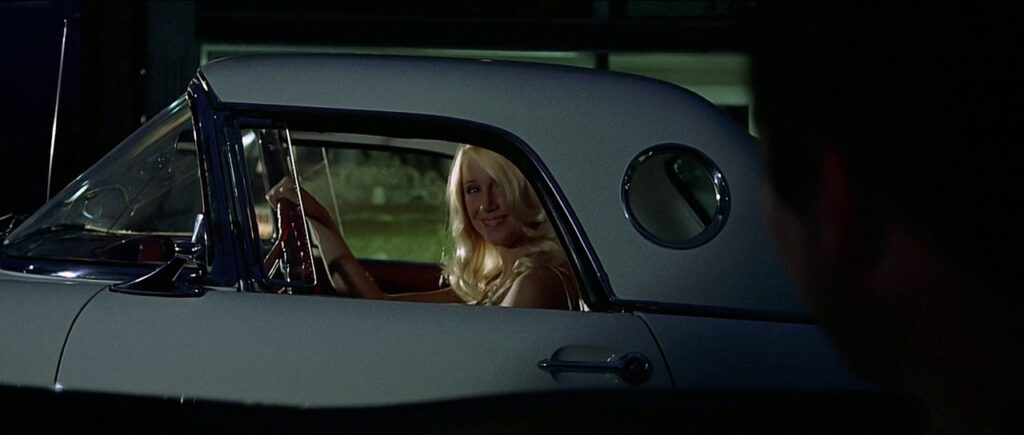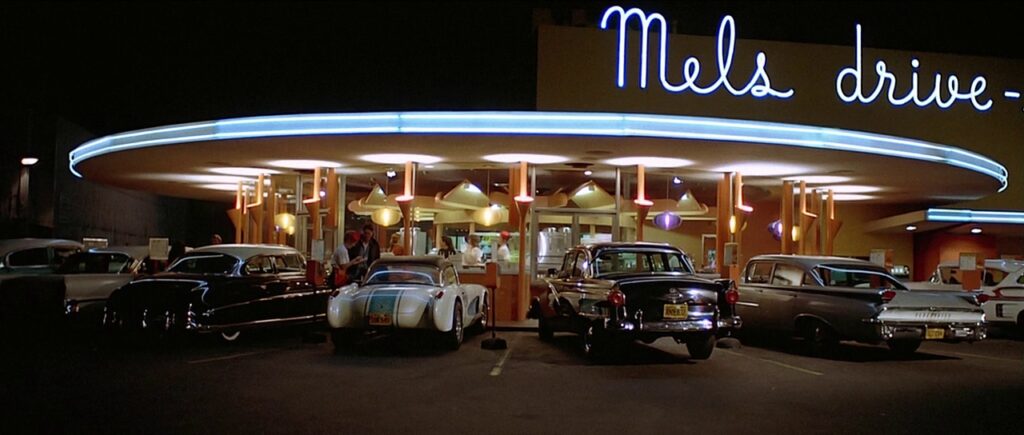“Hey Wendy, where are you going?”
“Nowhere.”
“Well, you mind if I come along?”
The radio echoes throughout AMERICAN GRAFFITI, its analog wispiness haunting the film like a spectral transmission from another faint, perhaps long-lost dimension, where Wolfman Jack howls into the night in perpetuity, acting as phantom, prophet, and Greek Chorus all at once. But the iconic disc jockey is mostly a phantom because AMERICAN GRAFFITI is a ghost story, and the haunted house is 1970s America unable to exorcize the specter of a past that only existed in its cultural memory. George Lucas’s idyllic recreation of his misspent youth often feels less like nostalgia and more like a conjured spirit, raised not for a wistful escape but to torment us with what has been lost — or what we think was lost. It wasn’t the first film to indulge in nostalgia, but it’s arguably the best at recognizing its phantasmic nature, the way it can bring pain as much as it brings pleasure, like a phantom limb of memory aching to recall something just out of reach. The radio is Lucas’s most potent totem, a cultural wellspring that instantly transports the audience back to 1962, and Walter Murch’s revolutionary sound design gives it an ethereal quality. It floats on the wind, weaving through the airwaves that tether its cast of characters in a tapestry of early rock and doo-wop hits, here reconfigured as a valedictory soundtrack bidding farewell to the fading embers of summer — and so much more.

When the Wolfman unleashes his final howl into the dawn, everything will change: Steve Bolander (Ron Howard) and Curt Henderson (Richard Dreyfuss) are headed east to college, leaving Terry “The Toad” Fields (Charles Martin Smith) behind to finish out his senior year alone. Steve will also be leaving behind longtime girlfriend Laurie (Cindy Williams), and the looming specter of their impending departure will strain — and strengthen — their relationship over the course of the night because that’s how it works at this age: every moment somehow feels like the most important of your life in one way or another, and it’s only after the hormonal dust settles that it becomes clear where you stand. Just about the only principal character who isn’t facing change is John Milner (Paul Le Mat), Modesto’s dragstrip king, though the arrival of enigmatic newcomer Bob Falfa (Harrison Ford) — who rolls into town in a jet black ‘55 Chevy with a skull dangling from his rearview mirror — portends the beginning of the end of this legendary reign. In the meantime, he’s stuck with Carol (Mackenzie Phillips), a preteen chatterbox who will only catch a fleeting glimpse of this lifestyle before it fades away — after all, by the time she’s Milner’s age, it’ll be the early 70s, a far cry from this halcyon depiction of 1962.
In the grand scheme of things, none of this drama is of the utmost importance. It’s literally kids’ stuff: high school relationship drama, a mysterious blonde in a Thunderbird, illicit booze, cruising, reckless displays of masculine pride. And yet, this is everything, these last, desperate pangs of adolescence stretching from dusk to dawn. It’s the foundational paradox in a film littered with them, a film that’s both a microcosm of a specific era and a font of universal truth all at once. AMERICAN GRAFFITI’s portrait of wayward youth is timeless in many respects (its spiritual successor DAZED & CONFUSED is a testament to this), yet it’s also irrevocably tethered to 1962, pointedly before the escalation of the Vietnam War and JFK’s assassination.

All generational change is inherently stark, but the 11 years that separate AMERICAN GRAFFITI’s release date and its setting is a particularly legendary chasm that severed America, splitting its history into two distinct parts: the idyllic good old days and everything that came after — war, strife, revolution, Watergate. It’s bullshit of course, but it’s a crucial pillar of Baby Boomer mythology: the notion that America (and, by extension, their entire generation) was once a land of carefree innocence and promise that was violently yanked from them. Every preceding and succeeding generation surely chafes at the notion, but Lucas isn’t just printing the legend in AMERICAN GRAFFITI — he’s transmitting it over AM airwaves and preserving it with nostalgia-tinted cinematography. With the exception of an allusion to a character’s passing regret that her parents won’t let her listen to Wolfman Jack “because he’s a Negro,” the film largely ignores the racial strife that was engulfing large swaths of the country, not to mention America’s long history of racial injustice that lays waste to any claims of the country’s innocence.
But none of that is pertinent in AMERICAN GRAFFITI, a film that dwells in nostalgia and unwittingly captures the way both our individual and cultural memories tend to forget or ignore the unsavory aspects of the past that we’re not attuned to as a child. Nostalgia itself is a paradox because it feels so intensely pure and true, yet it’s deceptive, a lie we tell for comfort, or a dagger we fashion for existential torment because those pangs soothe and sear all at once. AMERICAN GRAFFITI is the great American paradox writ large: a portrait of a fabled promised land that never really existed but persists in our mythology, haunting us with a vision of wistful Americana that only exists on celluloid and in dreams.

Then there’s the ultimate paradox: AMERICAN GRAFFITI is so vibrant and full of life, yet it’s full of ghosts. All movies are ghost stories in the sense that they preserve fleeting moments that linger on across time and death, but Lucas practically conducts a seance in raising these spirits from the ether of memory. That spectral quality in the sound design gives the impression of tuning into a fading frequency that may dissipate at any moment. In fact, Lucas insists on this ephemera because AMERICAN GRAFFITI itself is haunted by its director’s acknowledgment of a grim future where this idyllic vision of misspent youth will feel like the stuff of fantasy. Many of these acknowledgments happen during stark moments of silence: Curt finding himself at a literal crossroads, Milner taking Carol on an eerie tour of a junkyard littered with the cars of vanquished rivals, the stunning final title sequence that reveals that only one of the principal characters made it out of Modesto alive. Silence never sounds as unsettling as it does when the jukebox winds down after a long night of rocking around the clock, signaling the end of so much: summertime, childhood, this fabled vision of lost Americana.
This revelation is one of the most devastating gut punches in cinematic history, a final sledgehammer shot that confirms what we’ve known but refused to believe: that none of this can last forever. AMERICAN GRAFFITI. You can’t help but feel it in some of the film’s fleeting moments of irony: Curt might become a presidential advisor, but he’s never going to shake JFK’s hand. Steve might be adamant about leaving his dead-end hometown, but he feels destined to settle down there. Toad insists Milner will reign supreme forever, with the latter vowing to take on all challengers, but you suspect his ‘32 Ford will one day rust into obscurity in that graveyard of mangled, charred metal. Whatever idyllic futures these kids were supposed to have are no more real than the idyllic past they inhabit.

While Lucas insists that nothing this pure can last, that it’s all melting away just like Wolfman Jack’s popsicles, we know that it never really existed at all. 1962 could not have possibly been as perfect as it seems here, where even the acts of delinquency — the vandalism, the property damage, petty theft, pranks — seem utterly harmless. Even The Pharaohs, a gang of local roughnecks led by a folksy Bo Hopkins, are somehow charming even when they’re leading Curt astray. Nothing bad can really happen during this last night in town, where youth and innocence prevail. It’ll never last though, nor did it ever really happen exactly like this, but AMERICAN GRAFFITI is so vividly realized and deeply felt that it makes you want to believe in mythical halcyon days. It makes you want to believe in ghosts.
Tags: Bo Hopkins, candy clark, Cars, Charles Martin Smith, Cindy Williams, Del Close, Francis Ford Coppola, George Lucas, Gloria Katz, harrison ford, Haskell Wexler, Jan D'Alquen, Kathleen Quinlan, Kay Lenz, Lucasfilm Ltd., Mackenzie Phillips, Marcia Lucas, music, Paul Le Mat, Richard Dreyfuss, Ron Eveslage, Ron Howard, Suzanne Somers, The 1960s, The 1970s, The Coppola Company, Universal Pictures, Verna Fields, Walter Murch, Willard Huyck, Wolfman Jack



No Comments